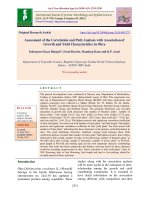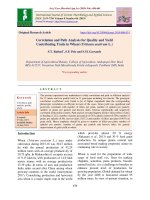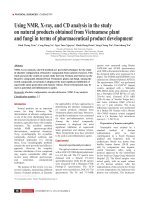Correlation and path analysis in annual chrysanthemum [Chrysanthemum coronarium L.]
Bạn đang xem bản rút gọn của tài liệu. Xem và tải ngay bản đầy đủ của tài liệu tại đây (264.61 KB, 7 trang )
Int.J.Curr.Microbiol.App.Sci (2019) 8(9): 936-942
International Journal of Current Microbiology and Applied Sciences
ISSN: 2319-7706 Volume 8 Number 09 (2019)
Journal homepage:
Original Research Article
/>
Correlation and Path Analysis in
Annual Chrysanthemum [Chrysanthemum coronarium L.]
M.P. Bindhushree*, B.C. Patil, Mukund Shiragur, Sateesh R. Patil,
Amruta S. Bhat and Dileep Kumar A. Masuthi
Department of Floriculture and Landscape Architecture, Kittur Rani Channamma College of
Horticulture, Arabhavi – 591 218, Karnataka, India
*Corresponding author
ABSTRACT
Keywords
Correlation and path
analysis,
Chrysanthemum
Article Info
Accepted:
15 August 2019
Available Online:
10 September 2019
The study was conducted during the year 2018-2019 at Department of Floriculture and
Landscape Architecture, Kittur Rani Channamma Collage of Horticulture, Arabhavi.
to study the correlation and path analysis in twenty different annul chrysanthemum
genotypes. The Correlation studies revealed highly significant and positive association
of flower yield per plant with individual flower weight (0.922), days to harvest
(0.773), number of flowers per plant (0.709), plant height (0.614), number of
secondary branches (0.571), duration of flowering (0.433) and number of leaves
(0.407) suggesting the possibility of simultaneous selection for these traits for
improving yield. Path analysis showed that flower yield per plant was significantly
and directly influenced by individual flower weight (1.165), number of flowers per
plant (0.551), days for 50% flowering (0.318), number of leaves (0.342), plant spread
in East-West (0.098), North-South direction (0.006), and number of primary branches
(0.026) which indicated the possibility of increasing flower yield by selecting these
characters directly.
Introduction
Glebionis
coronaria,
formerly
called
Chrysanthemum coronarium L. is an
important member of daisy family or
Asteraceae. It is a branching annual with
finely cut foliage reaching height up to a
meter, size of the flower varies from 2.5-4 cm
in diameter and color is usually in shades of
yellow and white having single or double
forms (Desai, 1962) with cream zones at the
centre
(Vishnuswarup,
1967).
It
is
supplementing the production of Florist
chrysanthemum in many areas of our country
and is occupying an area of about 5 per cent of
total area under chrysanthemum, Annual
chrysanthemum differs from the Florist’s
chrysanthemum in many aspects such as,
relatively short duration, less photosensitive,
grows taller, more vigorous and hardy. It is
used as a leafy vegetable, flowers are edible
and petals are used fresh or dried as a garnish
or to brew a tea. It produces large sized
attractive blooms for making garlands and for
936
Int.J.Curr.Microbiol.App.Sci (2019) 8(9): 936-942
decorations during the religious rituals. As a
cut flower it makes bold arrangement due to
the availability of a long stems (Desai, 1962).
Yield is a complex character resulting from
multiplicative
interactions
of
various
components. Therefore, correlation studies
between yield and other traits will be of
interest to breeders in planning the
hybridization programme and evaluating the
individual plants in segregating populations.
The correlation between various components
and yield can present a confusing picture, for
this reason path coefficient affords a much
more realistic interpretation of the factor
involved. Therefore, it is imperative to use the
technique of path analysis by which analysis
of correlation as a system of related variable is
possible.
The presence and magnitude of genetic
variability in a gene pool is the pre-requisite of
a breeding programme (Bhujpal et al., 2013).
Apart from this correlations as well as path
coefficient are important tools for the selection
of desirable traits and to enhance the
productivity of the annual chrysanthemum.
The main objective for a plant breeder is to
evolve high yielding varieties. It is therefore,
desirable for plant breeder to know the extent
of relationship between yield and its various
components, which will facilitate selection
based on component traits (Prasad et al.,
2011). Keeping in view the above facts
present investigation was undertaken with an
objective to analyze and determine the traits
having greater interrelationship with flower
yield utilizing the correlation and path analysis
and to help breeders in improvement of annual
chrysanthemum.
Materials and Methods
The study was conducted during the year
2018-2019 at Department of Floriculture and
Landscape
Architecture,
Kittur
Rani
Channamma
Collage
of
Horticulture,
Arabhavi. Investigation was carried out in
randomized complete block design, with two
replications and twenty different annual
chrysanthemum genotypes, which represent
diverse characters. One month old seedling
were transplanted into the main field with
spacing of 30×30cm. Observations were
recorded for best 5 plants in each genotype for
plantheight (cm), number of primary and
secondary branches per plant, plant spread in
East-West and North-South direction(cm),
number of leaves, leaf area, days taken for
flower bud initiation, days to 50 percent
flowering, days taken for complete flowering,
days to harvest, duration of flowering (days),
number of flowers per plant, individual flower
weight (g), flower yield (g/plant), flower yield
per plot, flower yield per hectare, test weight
and seed yield (g/plant).The observations were
recorded at an interval of 30 days from
transplanting till completion of harvest.
The estimates of correlation coefficient were
done by the method suggested by Hayes et al.,
(1955) and Al-jibouri et al., (1958). The path
coefficient analysis was carried out by using
the technique outlined by Dewey and Lu
(1959) for flower yield and its components
keeping flower yield as resultant variable and
its component as causal variables.
Results and Discussion
Association analysis
The simple correlation coefficients between
yield and various yield components and
interrelationship among the traits were
computed and they are presented in Table 1.
The results obtained through the correlation
coefficients indicate a strong association
between plant morphological characters with
yield. A positive correlation between desirable
characters is favorable to the plant breeder
937
Int.J.Curr.Microbiol.App.Sci (2019) 8(9): 936-942
which helps in simultaneous improvement. In
general, genotypic correlation was higher than
phenotypic correlations for most of the
characters studied. Genotypic correlation also
provide an estimate of inherent association
between genes controlling any two characters
thus formulating an effective selection
scheme. Further the phenotypic expression of
correlation is reduced due to the influence of
environment.
Correlation studies revealed highly significant
and positive association of flower yield per
plant with individual flower weight (0.922),
days to harvest (0.773), number of flowers per
plant (0.709), plant height (0.614), number of
secondary branches (0.571), duration of
flowering
(0.433)
and
number
of
leaves(0.407), suggesting the possibility of
simultaneous selection for these traits for
improving yield.
Similar trend was observed for correlation of
plant height with flower yield per plant by
Basavaraju (2006) in dahlia, Suvija et al.,
(2016), Atul et al., (2018) in chrysanthemum.
Singh and Singh (2005) in marigold also
reported the same result for correlation with
number of flowers per plant with individual
flower weight, Number of flowers per plant
showed significant and positive correlation
with flower yield per plant. Similar results
were shown by Ravikumar and Patil (2003)
and Naik et al., (2004) in China aster, Suvija
et al., (2016) in chrysanthemum,
Plant height exhibited significant and positive
correlation with number of primary branches
(0.323), number of secondary branches
(0.890), number of leaves (0.883), individual
flower weight (0.487), days to harvest (0.528),
number of flowers per plant (0.882) and
flower yield per plant (0.614). Correlation of
plant height with number of leaves is in
accordance with Ranchana et al., (2013) in
tuberose.
Thus selection of taller plants result in wider
canopy, higher yield owing to increase in
photosynthetic area. Similar trend was
observed for correlation of plant height with
flower yield per plant by Basavaraju (2006) in
dahlia.
Path analysis
Yield is a complex character and is composed
of component characters which contribute
directly as well as indirectly through each
other. The study of correlation alone when
considered on the criteria for selection for
high yield would be misleading. Since a
character may not be directly correlated with
yield but may be depend on other characters,
by path analysis it is possible to find out the
direct and indirect influence of component
characters on the yield. The technique of path
analysis developed by Wright (1921) and
demonstrated by Dewey and Lu (1959)
facilitates in partitioning the correlation
coefficients into direct and indirect
contribution of various characters to the yield.
The simple correlation coefficient of annual
chrysanthemum was apportioned into direct
effects and indirect effects by path analysis
and the results are presented in Table 2.
The residual effect (0.0237) of the path
analysis was low, indicating that the character
considered for path analysis was appropriate.
Path analysis showed that flower yield per
plant was significantly and directly influenced
by individual flower weight (1.165), which is
in accordance with the results of Kameshwari
et al., (2015), Suvija et al., (2016) and Hebbal
et al., (2018) in chrysanthemum, number of
flowers per plant (0.551), Deka and Paswan
(2002) in chrysanthemum reported similar
association with number of flowers per plant,
days for 50% flowering (0.318), number of
leaves (0.342).
938
Int.J.Curr.Microbiol.App.Sci (2019) 8(9): 936-942
Table.1 Estimates of genotypic correlation coefficients in annual chrysanthemum genotypes
Trait
no
1
2
3
4
1.
2.
3.
4.
1.000
-0.200
-0.172
0.323*
1.000
0.323*
0.890* -0.375* 0.883**
*
-0.498** -0.168 0.573** -0.316*
1.000
-0.306
1.000
5
6
5.
6.
7.
8.
9.
0.487**
0.528**
0.148
10.
11.
12.
13.
14
15
0.882**
-0.274
0.051
-0.064**
-0.003
0.614**
-0.185
-0.074
-0.164
0.322*
0.164
-0.294
0.192
-0.171 0.586**
-0.044
-0.077
-0.251
-0.407**
-0.106
0.403**
0.181
-0.257
-0.207
0.125
-0.263
0.309
-0.032
0.176
0.392*
-0.139
-0.366*
-0.363*
0.104
0.057
1.000
-0.357* 0.838**
0.492**
0.554**
0.748**
-0.192
0.119
-0.581**
0.053
0.571**
-0.373*
-0.318*
-0.671** -0.485**
-0.265
-0.125
0.223
-0.430**
-0.388*
1.000
0.262
0.405**
0.751**
-0.140
0.065
-0.502**
0.130
0.407**
1.000
0.849**
0.481**
0.004
0.577**
-0.159
0.150
0.922**
1.000
0.561**
0.234
0.562**
-0.067
0.416**
0.773**
1.000
-0.212
0.042
-0.567**
0.056
0.709**
1.000
0.370*
0.793**
1.000
0.430**
0.286
0.433**
1.000
0.569**
-0.363*
1.000
0.053
1.000
7
8
9
10
11
12
13
14
15
0.898** -0.127
1.000
*Significant at P=0.05**Significant at P=0.01
1. Plant height (cm)
2. Plant spread (cm)in [E-W]
3. Plant spread(cm) in [N-S]
4. Number of primary branches
r value at 5% = 0.311 and 1% = 0.402
5. Number of secondary branches 9. Days to harvest
6. Leaf area (cm2)
10. Number of flowers per plant
7. Number of leaves
11. Days for 50% flowering
8.Individual flower weight
12. Duration of flowering (days)
939
13.Days to flower bud initiation
14. Days for complete flowering
15. Flower yield per plant (g)
Int.J.Curr.Microbiol.App.Sci (2019) 8(9): 936-942
Table.2 Estimates of genotypic path coefficient analysis in annual chrysanthemum genotypes.
Trait
No.
1
2
3
4
5
6
7
8
9
10
11
12
13
14
rG
1
-0.570
0.113
0.098
-0.183
-0.507
0.214
-0.503
-0.277
-0.300
-0.502
0.156
-0.029
0.366
0.001
0.614**
2
-0.019
0.098
0.031
-0.048
-0.016
0.056
-0.031
0.014
-0.018
-0.007
-0.016
0.031
0.016
-0.028
0.192
3
-0.001
0.001
0.006
-0.001
-0.001
0.003
-0.002
-0.004
-0.001
-0.002
-0.006
0.002
0.001
-0.001
-0.207
4
0.008
-0.013
-0.008
0.026
0.003
-0.006
0.008
-0.008
0.004
0.010
-0.003
-0.009
-0.009
0.002
0.057
-0.041
-0.024
-0.027
-0.037
0.009
-0.005
0.028
-0.002
0.571**
0.053
0.045
0.095
0.069
0.037
0.017
-0.031
0.061
-0.388*
5
-0.044
0.008
0.008
-0.006
-0.049
6
0.053
-0.081
-0.083
0.050
7
0.302
-0.108
-0.014
0.037
0.105
0.017
-0.142
0.286
-0.127
0.342
0.089
0.138
0.257
-0.048
0.022
-0.171
0.044
0.407**
0.305
1.165
0.989
0.560
0.004
0.672
-0.185
0.174
0.922**
8
0.567
0.172
-0.089
-0.037
0.573
-0.371
9
-0.197
0.069
0.094
-0.066
-0.207
0.251
-0.152
-0.318
-0.375
-0.210
-0.087
-0.210
0.025
-0.155
0.773**
10
0.486
-0.041
-0.224
0.215
0.412
-0.267
0.414
0.265
0.309
0.551
-0.116
0.022
-0.312
0.030
0.709**
11
-0.087 -0.052
-0.033
-0.044
-0.061
-0.006
-0.084
-0.044
0.001
0.074
-0.067
0.318
0.117
0.252
0.285
-0.127
0.006
-0.003
-0.029
-0.028
-0.002
-0.019
-0.051
-0.022
-0.014
0.433**
0.106
-0.040
0.092
0.029
0.012
0.103
-0.145
-0.078
-0.183
-0.104
-0.363*
-0.012
0.103
-0.031
-0.036
-0.099
-0.013
-0.215
-0.068
-0.136
-0.240
0.053
12
-0.002 -0.016
-0.020
13
0.117
-0.030
-0.033
0.018
0.066
14
0.006
0.070
0.061
-0.025
Residual effect = 0.00237Bold diagonal figures indicate direct effect
*Significant at P=0.005
1. Plant height (cm)
5. Number of secondary branches
2. Plant spread (cm)in [E-W]
6. Leaf area (cm2)
3. Plant spread(cm) in [N-S]
7. Number of leaves
4. Number of primary branches 8. Individual flower weight
rG = Genotypic correlation coefficient of flower yield per plant
**Significant at P=0.01
9. Days to harvest
13. Days to flower bud initiation
10. Number of flowers per plant
14. Days for complete flowering
11. Days for 50% flowering
15. Flower yield per plant (g)
12.Duration of flowering (days)
940
Int.J.Curr.Microbiol.App.Sci (2019) 8(9): 936-942
Basavaraju (2006) in dahlia reported similar
association with number of leaves and days
for 50% flowering. plant spread in EastWest (0.098), North-South direction (0.006),
and number of primary branches (0.026)
which indicated the possibility of increasing
flower yield by selecting these characters
directly.
wheat grass seed production. Agron. J.
51: 515-518.
Basavaraju, G. H., 2006, Variability studies
in dahlia (Dahlia variabilis L.). M. Sc.
Thesis, Univ. Agric. Sci., Dharwad,
India.
Suvija, N. V., Suresh, J., Subesh, R. K., and
Kannan, M., 2016, Evaluation of
Chrysanthemum
cultivars
(Chrysanthemum morifolium Ramat.)
Genotypes for loose flower, cut flower
and pot mums. Inter. J. Innov.
research and advanced studies,3(4):
2394-4404.
Atul, P., Kumar, M., Singh, C., Kumar, A.,
Badal, D. S. and Singh, S., 2018,
Correlation and path analysis studies
in chrysanthemum (Dendranthema
grandiflora
Tzvelev).
J.
of
Pharmacognosy and Phytochemistry .
7(2): 3890-3893.
Singh, D. and Singh, A. K., 2005,
Correlation and path coefficient
analysis in marigold (Tagetes spp.).
Prog. Hort., 37(2): 385-388.
Ravikumar, H. and Patil, V. S., 2003,
Genetic variability and character
association studies in China aster
(Callistephus chinensis) genotype. J.
Orna. Hort., 6(3): 222-228.
Naik, B. H., Basavaraj, N. and Patil, V. S.,
2004, Correlation studies in China
aster (Callisthephus chinensis Ness.)
genotypes. J. Orn. Hort., 7(3-4): 8186.
Ranchana, P., Kannan, M. and Jawaharlal,
M., 2013, Genetic and correlation
studies in Double genotypes of
Tuberose (Polianthes tuberosa) for
assessing the genetic variability. Adv
Crop Sci Tech.1: 109.
Wright, S., 1921, Correlation and causation.
J. Agric. Res., 20: 557-585.
Kameshwari, P. L., Pratap, M., Begum, H.
U. and Anuradha, G., 2015, Studies
on genetic variability and character
Negative direct effect was observed through
plant height (-0.570), leaf area (-0.142), days
to harvest (-0.375), duration of flowering (0.051), days to flower bud initiation (0.183), days for complete flowering (-0.240)
and number of secondary branches (-0.049).
References
Desai, B. L., 1962, Chrysanthemum. In:
Seasonal flowers, Eds. Desai, B. L.,
Indian Council of Agricultural
Research, New Delhi, 64-65.
Bhujbal, G. B., Chavan, N. G. and Mehetre,
S. S. 2013. Evaluation of genetic
variability heritability and Genetic
advances in gladiolus (Gladiolus
grandiflorus L.) genotypes. The
Bioscan. 8(4): 1515-1520.
Prasad, Y., Kumar, K. and Mishra, S. B.
2011. Studies on genetic parameters
and inter-relationships among yield
and yield contributing traits in
Pigeonpea [Cajanus cajan (L.)
Millsp.]. The Bioscan. 8(1): 207-211.
Hayes, H. K., Immer, F. R. and Smith, D.
C. 1955. Methods of Plant Breeding.
(2 ed.). Mc Graw Hill Book Co. Inc.
New York. p. 551
Al-Jabouri, R. A., Miller, P. A. and
Robinson, H. F. 1958. Genotypic and
environmental variance in upland
cotton cross of interspecific origin.
Agron. J. 50: 633-637.
Dewey, D. R. and Lu, K. H. 1959. A
correlation and path co-efficient
analysis of components of crested
941
Int.J.Curr.Microbiol.App.Sci (2019) 8(9): 936-942
association for yield and its attributes
in chrysanthemum (Dendranthema
grandiflora Tzvelev). Agric. Sci.
Digest., 35(1): 25-30.
Hebbal, M., Shiragur, M., Naika, M. B. N.,
Seetharamu, G. K., Nishani, S. and
Patil, B. C., 2018, Genotypic and
phenotypic path analysis for flower
yield
inchrysanthemum
(Dendranthema grandiflora Tzvelve).
How to cite this article:
Int.J.Curr.Microbiol.App.Sci.
7(8):
4515-4521.
Deka, K. K. and Paswan, L., 2002,
Correlation and path analysis studies
in chrysanthemum. Int. Information
System
for
the
Agric.
Sci.
Technol.4(5): 40-45.
Vishnu
Swarup.
1967.
Garden
Flowers.National book Trust, India.
Bindhushree, M.P., B.C. Patil, Mukund Shiragur, Sateesh R. Patil, Amruta S. Bhat and Dileep
Kumar A. Masuthi. 2019. Correlation and Path Analysis in Annual Chrysanthemum
[Chrysanthemum coronarium L.]. Int.J.Curr.Microbiol.App.Sci. 8(09): 936-942.
doi: />
942





![Studies on correlation and path analysis for grain yield and quality components in foxtail millet [Setaria italica (L.) Beauv.]](https://media.store123doc.com/images/document/2020_01/09/medium_dyd1578574836.jpg)

![Genetic variability, diversity and character association in sponge gourd [Luffacylindrica (Roem.) L.]](https://media.store123doc.com/images/document/2020_01/13/medium_tig1578934486.jpg)

